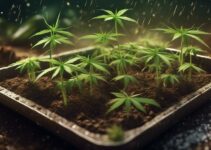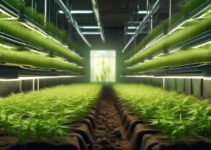If you're looking to plant the seeds of success with reliable germination, consider the advantages of autoflowering seeds. They're like the dependable Swiss army knife of the seed world, offering a variety of benefits that can enhance your growing experience. From faster growth cycles to resilience against environmental challenges, autoflowering seeds have much to offer. But there's more to discover about why they're a top choice for reliable germination.
Key Takeaways
- Autoflowering seeds offer a fast and reliable germination process, leading to quicker sprouting and shorter growing cycles.
- These seeds are resilient to environmental conditions, making them suitable for stealthy and discreet cultivation.
- Autoflowering seeds may have lower THC levels, which can be preferable for some users.
- To maximize germination yield, it is important to select high-quality seeds from reputable sources and consider autoflowering strains bred for rapid and consistent germination.
Benefits of Autoflowering Seeds
When considering the benefits of autoflowering seeds, their fast and reliable germination process stands out as a key advantage for cultivators. Unlike photoperiod strains, which require specific light cycles to trigger flowering, autoflowering plants are genetically programmed to flower based on age. This means that autoflowering plants have a shorter growing cycle, typically around 8-10 weeks from seed to harvest. This quick and easy turnaround is particularly beneficial for cultivators seeking a rapid harvest.
Autoflowering cannabis seeds are also known for their resilience to environmental conditions. Whether you are growing indoors or outdoors, autoflowering strains offer flexible growing options. Their ability to thrive in various conditions makes them suitable for stealthy and discreet cultivation. Additionally, autoflowering genetics tend to produce plants with lower THC levels, which may be preferable for some users.
For novice growers, autoflowering seeds are a low-maintenance and forgiving option. Their resilience and flexibility, combined with the fast-growing cycle, make them an attractive choice for those new to cultivation. Overall, the benefits of autoflowering seeds make them a popular choice for many cultivators.
Best Practices for Germination
With the benefits of autoflowering seeds in mind, ensuring reliable germination through best practices is essential for successful cultivation. To achieve this, consider the following best practices for germination:
- Use a proper germination method such as paper towel or water glass to ensure seeds are exposed to moisture and warmth for reliable sprouting.
- Keep the germination environment consistently warm, around 70-85°F, to promote quicker and successful sprouting.
- Maintain a consistent moisture level to prevent seeds from drying out or becoming waterlogged during the germination process.
- Monitor seeds for signs of germination such as the appearance of a taproot, and promptly transfer them to the growing medium once the root emerges.
- Label and track the germination progress of each seed to ensure proper care and attention is given to each sprout.
Ideal Germination Techniques
To achieve successful germination of autoflowering seeds, it is essential to start with high-quality seeds obtained from a reputable supplier. Ideal germination techniques play a crucial role in the successful cultivation of autoflowering seeds. Utilizing germination methods such as the paper towel, water glass, or peat pellet can significantly improve the germination process. These methods provide the necessary moisture and darkness for the seeds to sprout effectively. Maintaining a warm and moist environment is crucial during the germination phase. Consistent temperature and humidity levels support healthy seedling development, ensuring the best start for your autoflowering plants. Once the seeds have germinated, it is important to carefully transplant them into the growing medium to prevent damage to the delicate roots.
For indoor growers, creating an optimal environment within the grow room is essential for ideal germination. Outdoor growers should consider environmental factors and the natural light cycle to ensure successful germination. By following these ideal germination techniques, growers can maximize the potential of their autoflowering seeds and achieve successful and reliable germination.
Factors Affecting Germination Success
When it comes to the success of germination, the quality of the seeds you choose is paramount. Ensuring that the environmental conditions, such as temperature and humidity, are optimal will also greatly influence the outcome. Additionally, the treatment of the seeds, including the choice of soil, watering technique, and planting depth, will play a crucial role in determining the success of germination.
Seed Quality
How do different factors influence the germination success of autoflowering seeds? Seed quality plays a crucial role in the germination success of autoflowering cannabis strains. Factors affecting seed quality include genetics, storage conditions, and age. Here are some key aspects to consider:
- Genetics: High-quality autoflowering seeds are derived from stable and resilient genetics, ensuring consistent germination rates.
- Storage Conditions: Proper storage in a cool, dark, and dry environment helps maintain seed viability and germination potential.
- Age: Fresh seeds generally exhibit higher germination rates compared to older seeds, emphasizing the importance of seed freshness.
- Physical Damage: Seeds should be free from physical damage or deformities, as these can negatively impact germination.
- Nutrient Content: Adequate nutrient reserves within the seed contribute to successful germination and seedling vigor.
Understanding and prioritizing these factors can significantly improve the overall germination success of autoflowering seeds.
Environmental Conditions
Ensure that environmental conditions such as temperature, moisture, oxygen availability, light exposure, and soil type are optimized to support the successful germination of autoflowering seeds. For indoor grows, maintaining a consistent temperature between 70-85°F and a relative humidity of 70% during the seedling stage is crucial. In an outdoor setting, ensure that the seeds are planted during the growing season when the temperature and daylight hours are suitable for the cannabis plant. Oxygen availability in the growing medium is essential for the initial stages of growth, and using well-draining soil facilitates this. Additionally, understanding the light schedule is vital as autoflowering seeds have a predetermined life cycle, making them suitable for perpetual harvests and allowing growers to maximize yields, both indoors and outdoors.
Seed Treatment
To maximize germination success, carefully consider the optimal temperature and moisture levels required for seed treatment. When treating autoflowering seeds, novice growers should pay close attention to the following factors:
- Proper Depth: Ensure the seeds are planted at the right depth to access necessary oxygen and moisture.
- Light Exposure: Understand the light requirements of the seeds, as some may need darkness while others benefit from light.
- Seed Coat Inhibitors or Stimulants: Be aware of any inhibitors or stimulants present in the seed coat that may affect germination success.
- Soil Quality: Consider the soil's quality and composition as it can influence nutrient and water availability.
- Moisture Levels: Monitor and maintain appropriate moisture levels to support successful germination.
Understanding and addressing these seed treatment factors will contribute to reliable germination of autoflowering seeds, whether grown indoors or outdoors.
Maximizing Germination Yield
For maximizing your autoflowering seed germination yield, selecting high-quality seeds from reputable sources is essential to ensure a higher germination rate. When choosing autoflowering seeds, consider reputable suppliers offering top autoflowering genetics. The generation of autoflowering strains plays a crucial role in their reliability and germination potential. Autoflowering traits are often bred for rapid and consistent germination, making them a popular choice among cannabis growers. These seeds also tend to have lower THC levels, and they can exhibit characteristics of both indica and sativa varieties.
To maximize your germination yield, it's important to use a germination method that best suits autoflowering seeds. Techniques such as the paper towel or direct soil method can encourage successful and rapid germination. Ensure consistent and appropriate moisture levels to promote seed swelling and germination, avoiding overwatering or underwatering. Additionally, maintaining a stable and warm environment, ideally around 70-85°F (21-29°C), can encourage quicker and uniform germination. Consider using germination aids such as seedling heat mats or humidity domes to create an optimal germination environment and increase the overall yield potential. By following these guidelines, you can optimize the germination yield of your autoflowering seeds.
Troubleshooting Germination Issues
If you encounter germination issues, start by assessing the viability of your seeds. Ensure they are fresh and from a reputable source. Then, take a close look at your watering and humidity levels, making sure to maintain proper moisture without overwatering. Finally, maintain precise temperature control, ideally between 70-85°F, to create an optimal germination environment.
Seed Viability Check
Checking the viability of seeds is an essential step in troubleshooting germination issues, ensuring that you start with the highest quality seeds for successful cultivation. Here are some tips for conducting a seed viability check:
- Float Test: Place the seeds in a container of water; viable seeds will sink, while non-viable ones will float.
- Germination Test: Use a paper towel or soil to germinate a few seeds and observe the germination rate.
- Seed Appearance: Healthy seeds are generally dark and have a hard outer shell.
- Size and Weight: Larger, heavier seeds often indicate better viability.
- Storage Conditions: Consider the storage environment of the seeds, as improper storage can reduce viability.
Watering and Humidity
When troubleshooting germination issues, ensuring proper watering and humidity levels becomes crucial for the successful cultivation of seeds. Overwatering can lead to rot and fungus, while underwatering can result in failure to sprout. Simultaneously, maintaining proper humidity levels is essential for seed germination. High humidity can lead to mold and mildew, while low humidity can cause slow or failed germination. Monitoring watering and humidity levels is crucial for troubleshooting germination issues. To illustrate the importance of proper watering and humidity, consider the following table:
| Factors to Consider | Potential Issues |
|---|---|
| Overwatering | Rot and fungus |
| Underwatering | Failure to sprout |
| High humidity | Mold and mildew |
| Low humidity | Slow or failed germination |
| Monitoring | Crucial for troubleshooting |
In autoflowering seeds, maintaining the correct watering and humidity levels is particularly vital due to their unique growth cycle and genetic makeup.
Temperature Control
Maintaining a consistent temperature range of 70-85°F is essential for ensuring successful germination of autoflowering seeds. Proper temperature control is crucial for the reliable germination of autoflowering seeds. Here are five tips for effective temperature control during germination:
- Use a seedling heat mat to maintain the optimal temperature for germination.
- Avoid exposing seeds to extreme temperatures, as both hot and cold conditions can hinder the germination process.
- Monitor and control the temperature in the germination environment to ensure the best conditions for seed germination.
- Cold temperatures can slow down the germination process, while excessively high temperatures can cause seeds to dry out and become unviable.
- For outdoor growers, utilizing functional cookies or other temperature-regulating devices can help maintain the ideal conditions for germination all year round, resulting in enhanced yields and high-quality crops.
Frequently Asked Questions
What Is the Benefit of Autoflowering Seeds?
Autoflowering seeds offer faster growth, low maintenance, and high yields. Their short life cycle is ideal for both outdoor and indoor setups. They provide stealth growing and high potency levels, thanks to genetics selection and stress resistance.
Should You Germinate Autoflower Seeds?
When germinating autoflower seeds, ensure proper soil preparation, light cycles, and watering schedules for optimal seedling care. Their resilience and fast growth cycle make them suitable for various growing techniques, with less need for nutrients.
What Is the Downside to Autoflowering Seeds?
The downside to autoflowering seeds includes their short lifespan, low yield, limited growth control, and reduced potency. They also have limited breeding potential, quick flowering, small size, reduced THC, and are less suitable for outdoor growing.
Why Do People Grow Autoflower?
People grow autoflower for its high yield potential, time savings, space efficiency, and quick harvest. Its adaptability to indoor and outdoor cultivation, low maintenance, and genetic selection make it ideal for high potency and climate adaptability.





